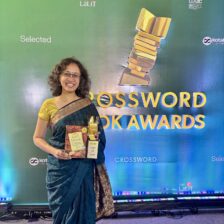It’s been four years since I attended the Asian Festival of Children’s Content.
2016 – my collection of short stories (now published as Dragonflies, Jigsaws and Seashells) was shortlisted for the Scholastic Asian Book Award, so I attended for the first time.
2017 – I submitted a paper titled Writing About Us, which was selected as part of a panel, so off I went for the second time.
2018 – my middle grade book (now published as Red Eyes) was the first runner-up for the Scholastic Asian Book Award, and yes, I attended the AFCC again.
I didn’t go in 2019 and then, with the pandemic, 2020 and 2021 were out of the question too. This year, Scholastic Asia sponsored a virtual ticket for me, so of course, I’ve been making the most of it. Attending virtually isn’t nearly as exciting as being there in person, but it does have one big advantage – I go back and attend sessions I missed because they’re available for viewing on the AFCC website for 30 days longer!
Keynote: Light Up with Literature!

Yes, this was 6:30 am for me, but the keynote address was well worth attending! I took away so much from the session – both from what the speakers said and how they spoke. Neil Humphreys is a humorous, fun storyteller, and I thoroughly enjoyed how he talked about what inspired him to write his stories. But most of all, what resonated with me was his answer to the question on how to be a writer.
His answer?
Write.
And I couldn’t agree more. There are no shortcuts. If you want to ride a bike, you get on a bike and practise, practise, practise. And if you want to be a writer, you just get with it and write.
Of course, in a festival that is all about children’s literature, there were several conversations about reading and ways in which children start their reading journeys. The moderator Kim Beeman, a librarian, pointed out how, increasingly, children are drawn to books because they love the movies based on them. That hasn’t happened to me, but I understand! A movie is just a snippet, and if you love it so much that you want more, you’ll turn to the book!
Another important idea for me is focusing on content rather than the medium. Parents and educators complain all too often about children watching trash online. It is worth noting that the trash is the problem, not the screen! Would we feel better about children reading virulent material in print? I loved the session – a great start to a packed day!
Depicting the ‘Unspeakable’

Sessions like Depicting the ‘Unspeakable’ help me understand how much is happening in the world of children’s literature. For instance, most of us have read about the war against drugs in the Philippines, Oplan Tokhang, and Cheeno Marlo Sayuno spoke of literature that addresses this theme head-on. Often, parents and educators are wary of introducing dark, difficult themes to children, but something that came through multiple times both during this session and during other sessions at the AFCC was that children do shine and glow no matter how harsh the circumstances.
Stories about unconventional families, gender, socio-political struggles, abuse, disability and social inclusion – all of these exist. Gatekeepers of literature, including librarians, educators and parents need to bridge the gap between the books and the children. I loved the session; it made me think. How courageous am I as a writer? And how courageous am I willing to be?
Writing about Children with Special Needs

The most powerful moment for me during the session on writing about children with special needs was when the moderator Quek Hong Shin asked, “What can parents of neurotypical children do to ease the path?”
This is such an important question, and one that is not asked nearly often enough.
I loved the responses too: language that we use at home finds its echoes in the language children use. Phrases like Don’t be silly! and Are you crazy? come from home. The moment children see other children doing something differently, they imitate things their parents say at home. That’s where parents of neurotypical children can be more mindful!
While Jill and Ilyana spoke from the perspective of parents of children with special needs, Abirami spoke as an educator. Not for the first time, an idea that was brought home to me was that inclusion is not the same as accommodation. Bringing a neurodiverse child into mainstream education and expecting them to adjust is not inclusion! Inclusion takes effort and time, and the willingness to make learning enjoyable for every child.
Keep Moving Forward: Growth and Development through Science and Picture Books

A few years ago, I would not have attended a session on STEAM, but I found this one rewarding, especially considering the number of workshops I conduct on reading and critical thinking. As a teacher trainer, two topics I regularly address are Bloom’s taxonomy and reading. And this sessionwas particularly interesting first to reaffirm what we already know – teaching through stories – and second, to look at activities we can do with stories we read.
However, one idea that stayed with me was that teaching a concept must go hand-in-hand with preserving the a sense of wonder. Yes, clouds are made of tiny water droplets. But isn’t it wonderful to look at the shapes of clouds and admire how fluffy they are? We find magic in rainbows, lava, slime, flowers … Magic is attractive and if we make each magical moment a teachable moment, we may ruin curiosity instead of sparking it.
That was the end of day one of AFCC 2022. Days two, three and four were equally exciting!

Leave a Reply